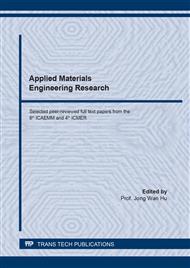[1]
K.V.L. Subramaniam, Identification of Early-Age Cracking in Concrete Bridge Decks, J. Perform. Constr. Facil. 30 (2016) 1–9.
DOI: 10.1061/(asce)cf.1943-5509.0000915
Google Scholar
[2]
N. Banthia, R. Gupta, Hybrid fiber reinforced concrete (HyFRC): Fiber synergy in high strength matrices, Mater. Struct. Constr. 37 (2004) 707–716.
DOI: 10.1617/14095
Google Scholar
[3]
A. Sivakumar, M. Santhanam, A quantitative study on the plastic shrinkage cracking in high strength hybrid fibre reinforced concrete, Cem. Concr. Compos. 29 (2007) 575–581.
DOI: 10.1016/j.cemconcomp.2007.03.005
Google Scholar
[4]
J.S. Lawler, D. Zampini, S.P. Shah, Permeability of cracked hybrid fiber-reinforced mortar under load, ACI Mater. J. 99 (2002) 379–385.
DOI: 10.14359/12220
Google Scholar
[5]
S. Gali, K.V.L. Subramaniam, Cohesive stress transfer and shear capacity enhancements in hybrid steel and macro-polypropylene fiber reinforced concrete, Theor. Appl. Fract. Mech. 103 (2019) 102250.
DOI: 10.1016/j.tafmec.2019.102250
Google Scholar
[6]
R.H. Evans, M.S. Marathe, Microcracking and stress-strain curves for concrete in tension, Matériaux Constr. 1 (1968) 61–64.
DOI: 10.1007/bf02479001
Google Scholar
[7]
A. Hillerborg, Analysis of fracture by means of the fictitious crack model, particularly for fibre reinforced concrete, Int. J. Cem. Compos. 2 (1980) 177–184.
Google Scholar
[8]
Roelfstra P. E. and Witmann F. H., Numerical method to link strain softening with failure of concrete, in: F.H. Wittmann (Ed.), Fract. Toughness Fract. Energy Concr., Elsevier Science Publishers B.V. Amsterdam, 1986: p.163–175.
Google Scholar
[9]
S.P. Gopalaratnam, V. S. ; Shah, Post-cracking characteristics of concrete in uniaxial tension, Eng. Mech. Civ. Eng. ASCE. 2 (1984) 1393–1398.
Google Scholar
[10]
S.H. Kwon, Z. Zhao, S.P. Shah, Effect of specimen size on fracture energy and softening curve of concrete: Part II. Inverse analysis and softening curve, Cem. Concr. Res. 38 (2008) 1061–1069.
DOI: 10.1016/j.cemconres.2008.03.014
Google Scholar
[11]
K. Reddy, Chiranjeevi, K.V.L. Subramaniam, Analysis for multi-linear stress-crack opening cohesive relationship: Application to macro-synthetic fiber reinforced concrete, Eng. Fract. Mech. 169 (2017) 128–145.
DOI: 10.1016/j.engfracmech.2016.11.015
Google Scholar
[12]
S. Gali, K.V.L. Subramaniam, Multi-linear stress-crack separation relationship for steel fiber reinforced concrete: Analytical framework and experimental evaluation, Theor. Appl. Fract. Mech. 93 (2018) 33–43.
DOI: 10.1016/j.tafmec.2017.06.018
Google Scholar
[13]
M. V. Bhogone, K.V.L. Subramaniam, Early-age Tensile Constitutive Relationships for Steel and Polypropylene Fiber Reinforced Concrete, Eng. Fract. Mech. (2021) 107556.
DOI: 10.1016/j.engfracmech.2021.107556
Google Scholar
[14]
BS EN 14651:2005+A1:2007, BS EN 14651:2005+A1:2007 Test method for metallic fibre concrete. Measuring the flexural tensile strength (limit of proportionality (LOP), residual), rue de Stassart, 36 B-1050 Brussels., (2005).
DOI: 10.3403/30092475
Google Scholar


